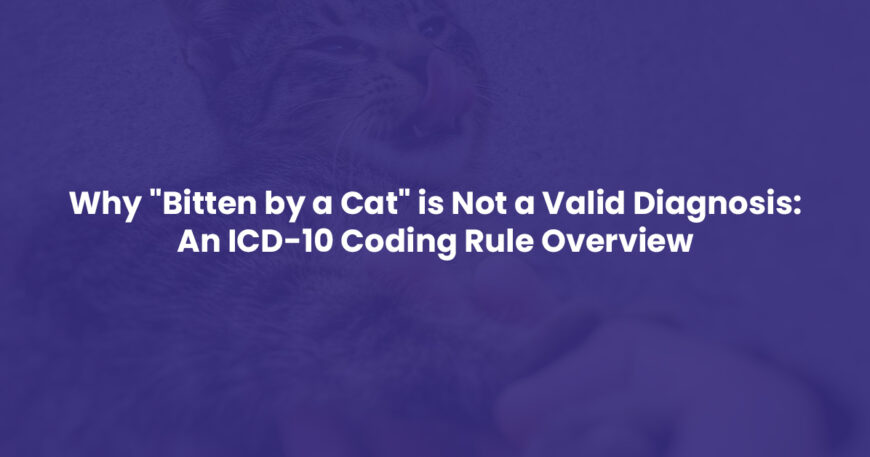The patient had come into the emergency room panicking after her cat had sunk its teeth into her hand.
“I’ve been bitten by a cat!” she exclaimed. The triage nurse clucked in sympathy as she examined the wound.
The clinician sighed as he filled out the diagnosis code for the patient’s chart. He knew that simply writing “bitten by a cat” or “fall” would not suffice according to the strict rules set by the health insurance companies. They demanded specificity.
Do you know why?
It’s because the medical coding submission rules state that the actual injury of the patient itself must be listed first. Was it a laceration that required stitches, a contusion that caused swelling, a fracture that necessitated a cast, or a sprain that needed bracing?
Therefore, here the doctor needs to determine the appropriate diagnosis code to represent the injury. Only then could he note the cause, whether the cat bite or the tumble down the stairs.
The health insurance payers want the facts in a particular order and so the clinician or the medical coder needs to oblige to claim reimbursement for the code submission.
The rules of medical billing are clear the condition comes first, the cause comes second. Only after the doctor diagnosed the condition itself could the external cause—the cat in this case—be listed as a secondary concern.
In another example: A man stumbling off a curb and twisting his ankle needs a diagnosis of a sprain. The fact that he fell off the curb needs to be noted afterward.
The coder needs to know the specific injury sustained, not just the cause. Here’s why?
According to the medical coding rules, simply stating that a patient was “bitten by a cat” or “fell” is not enough information for the coder to assign a valid diagnosis code. The coder needs to know the specific injury sustained, not just the cause.
If the doctor only notes that the patient was bitten or fell, the coder can only assign an external cause code to show how the injury occurred. Without knowing the particular wound or break, there can be no principal diagnosis.
💡 The principal diagnosis refers to the condition that, after study, was found to be the reason the patient sought treatment. For a visit to be considered valid and payable, there must be a principal diagnosis. Just saying a patient was bitten or fell does not give the coder enough details about the injury to determine a principal diagnosis.
If the doctor just writes “bitten by a cat” or “fall,” the coder can only assign a code denoting the cause. No code can be assigned for the actual injury. This results in an invalid claim, as there is no principal diagnosis. For the claim to be valid and payable, the provider must specify the details of the injury, such as a laceration, fracture, or sprain. Stating the cause of an injury alone is not sufficient. The coder needs information about the injury itself to assign the proper diagnosis and procedure codes.
In short, while it is important for the provider to note the cause of an injury, the specific injury sustained must also be clearly documented. Only by specifying the actual wound, break, or damage can the coder assign the proper codes to make a claim valid. The principal diagnosis is key, and that requires definitive information about the injury, not just its external cause.
An example on how to make “bitten by a cat” a valid diagnosis for coding 🐱
For example, if a patient presents with a wound from a cat bite, the physician must document the specific injury, such as “infected puncture wound of right hand.” The coder would then assign ICD-10 code S61.451A, “Open bite of right hand, initial encounter.” The external cause code, W54.0XXA “Bitten by cat, initial encounter” would also be assigned to provide context.
Simply stating “bitten by cat” does not indicate the severity or specific injury and would not be considered a valid diagnosis.

Understanding External Cause Codes
External cause codes capture how a person came to be injured, whether by accident or intentionally. These codes are found in chapter 20 of the ICD-10, titled “External Causes of Morbidity.” They are used along with the codes for specific injuries to provide details on the circumstances.
The external cause codes identify how the injury happened, if it was an accident or on purpose, where exactly it took place, and whether the person hurt was a civilian or in the military at the time.
An external cause code is not used if the details on how and why the injury occurred are already included in the code for the injury itself.
For instance, the code T36.0X1 for accidental poisoning by penicillin already tells us it was an accident involving penicillin, so no extra external cause code is required. Another example, the code T38.3X5A for adverse reaction to insulin includes both the cause (insulin) and intent (accidental), so no extra code is needed.
How to use them?
External cause codes can be used with any code from A00.0 to T88.9 or Z00 to Z99, to give the full details of an injury and how it came about. Coders are told to use as many external cause codes as are needed to properly describe the cause, intention, and location of the injury.
External cause codes require a 7th character extension that identifies the episode of care – an A for initial encounter, D for subsequent encounter, and S for sequela.
For example, say a man slips on ice and breaks his leg. For his first trip to the doctor, use code ‘A’ as it’s the initial encounter. At his check up a week later, use code ‘D’ to show it’s a subsequent encounter. If he needs physical therapy for a few months, those visits would use code ‘S’ to indicate treatment for the injury sequela.
The 7th character used for the external cause code must match the one used for the associated injury code on that specific bill. For instance, if the broken leg injury has a code with an ‘A’ for the initial visit, the slip and fall external cause code must also have a 7th character of ‘A’ on that same claim form.
External cause codes should never be the primary code on a medical claim form. The injury diagnosis code should be listed first, and the external cause code second. For example, the proper way to list codes for the man who broke his leg after slipping on ice would be to first list the code for the broken leg with a 7th character of ‘A’, then list the slip and fall code with a 7th character of ‘A’.
When done correctly, the medical coders and insurance companies can better understand the cause and full timeline of events for a patient’s injuries and treatment.
Are external cause codes required?
According to the official guidelines, a doctor is not obligated to provide an external cause code when submitting a claim for an injury. If a patient came into the emergency room with a nasty bruise after taking a spill down the front steps, the doctor could simply code it as a contusion and leave it at that.
However, many insurance companies insist on the full story and demand to know the ‘how’ behind the ‘what’. They want the details. For them, just knowing the injury occurred is not enough. They need to understand the cause.
Without an external cause code, such as a fall down steps in this case, the insurance company has an incomplete picture. They may deny the claim altogether or flag it for review. This creates headaches for everyone involved. The doctor’s office may have to appeal the decision or submit additional paperwork to get the claim processed. All this back and forth takes time and resources.
While doctors are not technically required by law to report the external cause, for practical reasons, most find it easier to just provide the full details upfront. A few extra codes save hours of hassle in the long run. The insurance companies get the information they want, the claim sails through, and the doctor gets paid for services rendered. For their part, the patient receives coverage without interruption. In the end, everyone wins when the external cause is included.
Though not an official mandate, for many the external cause code has become an unwritten requirement. It is the path of least resistance and helps the system function as intended. Patients go to doctors to get fixed up, doctors submit claims to get paid, and insurance companies need all the facts to determine appropriate benefits. The humble external cause code ties it all together.
Can a doctor submit an external cause ICD-10 code without an associated injury code? #MedicalCoder’sOpinion
When it comes to medical billing, getting the diagnosis codes right the first time around can save a heap of hassle down the road. Take, for instance, the common case of an external cause code submitted without its paired injury code.
Say a patient comes into the clinic with an infected cat bite on their hand. The doctor diagnoses it and treats it, but only lists the external cause code (bitten by a cat) without also including the injury code for the infected wound.
Well, once that claim gets to the insurance company, it’s likely to get kicked right back for being invalid. The denial reason will say something like “Principal diagnosis is invalid; external cause of injury code cannot be submitted alone.” So then the clinic has to resubmit the claim with the proper injury code added. And that slows down payment, plus creates extra administrative work.
The best way medical groups can avoid these kinds of snags is by closely reviewing the coding guidelines, especially for external cause codes. Remind physicians that those codes should never be the primary diagnosis. And confirm that any external cause code is accompanied by a code for the resulting injury or condition. Following the rules from the get-go means cleaner claims, faster payments, and less rework.
So in our cat bite example, the proper coding would be the injury code first, like “Infected open wound of hand,” along with the external cause code secondary, like “Bitten by a cat.” That clear pairing paints the complete diagnostic picture. And it’s the professional diligence of coders and clinicians alike that makes sure each claim tells the most accurate medical story possible. Doing so streamlines the process for all involved.
Diagnosis vs. External Cause Coding: Get Compliant with a Free Consult
Do diagnosis codes have you puzzled? Not sure when external cause codes apply? You’re not alone. Many providers find these coding categories complex. But improper coding can lead to claim denials and lost revenue.
But don’t worry. ProcareMedex is here to help.
From clarifying documentation requirements to reviewing your current coding, our experts are here to offer the support and solutions you need. Schedule a free initial call to connect with a consultant and ensure clean claims and optimal reimbursement for your practice.





